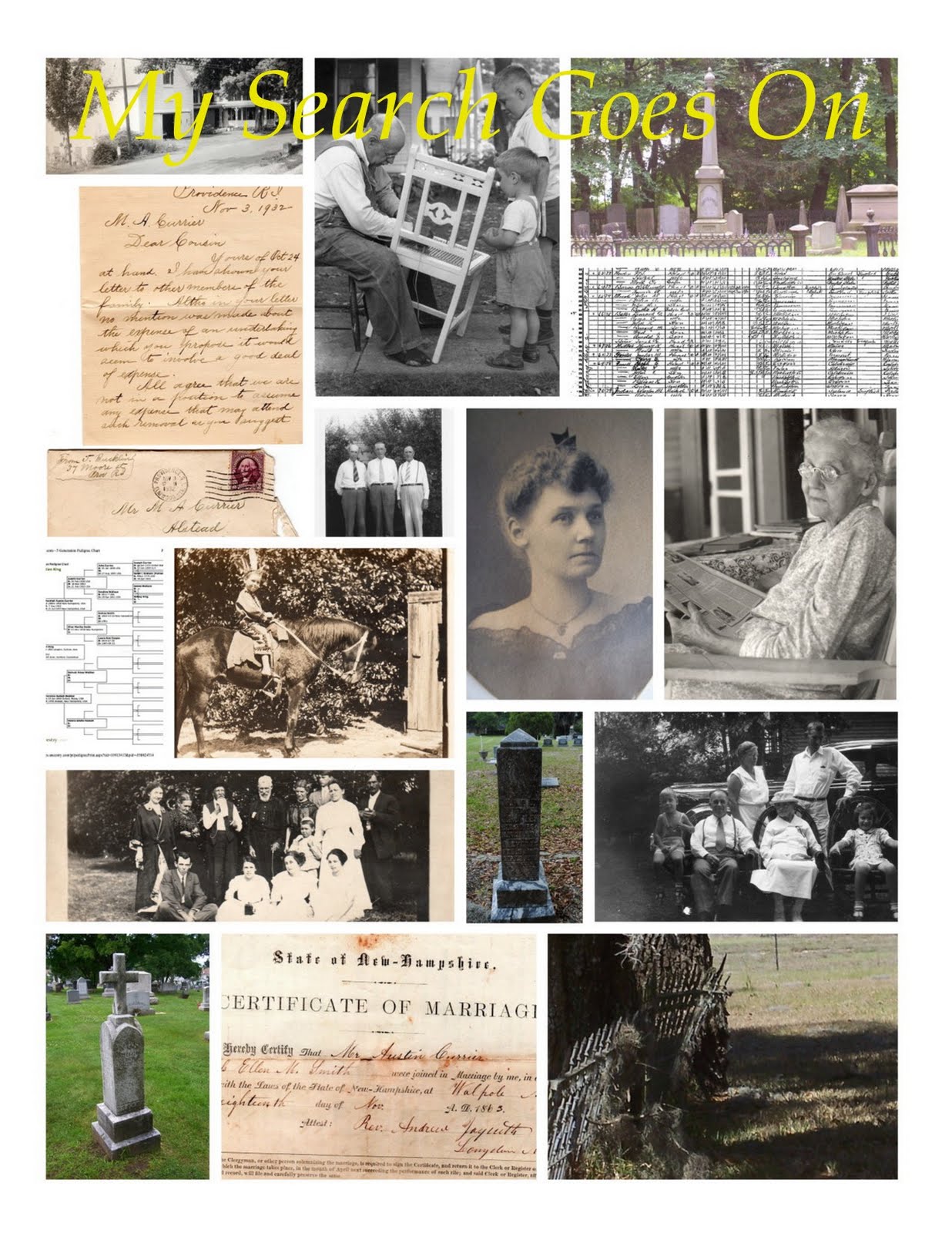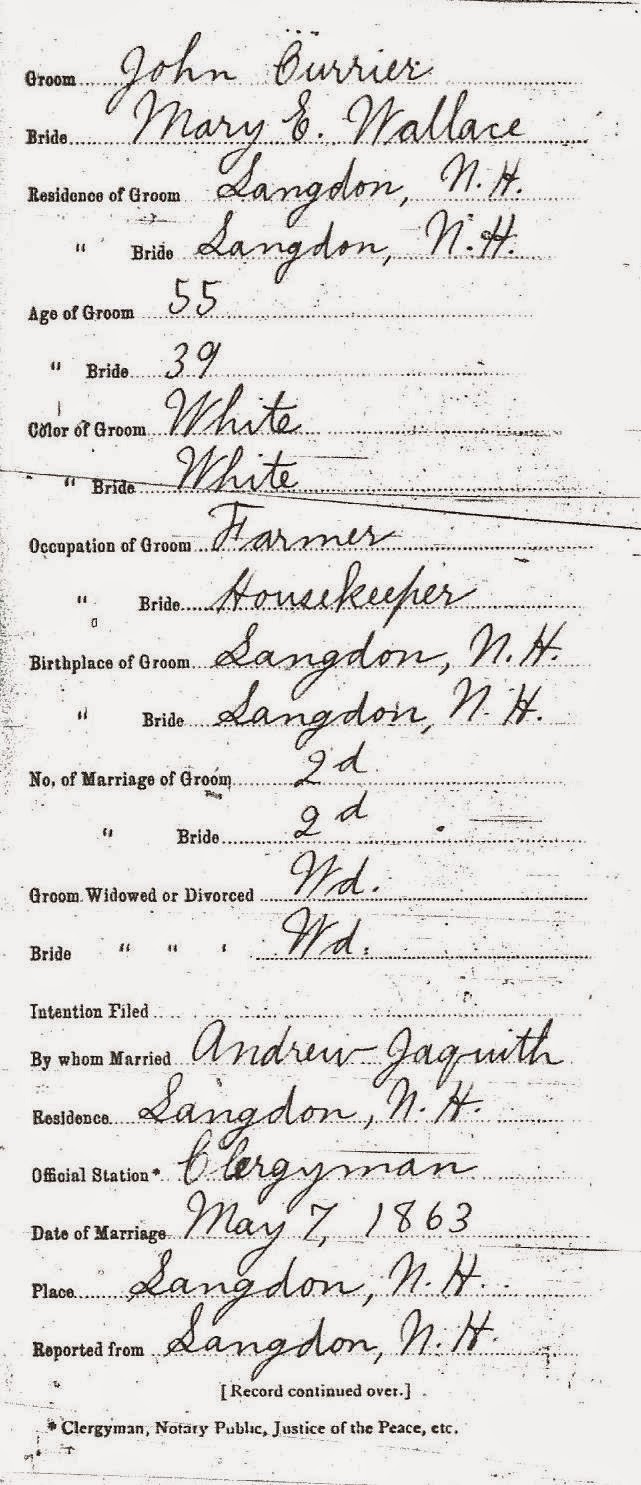Ten years later the 1860 Federal Census for Langdon, New Hampshire reveals that Mary has returned to her birth state and resides in the home of her widowed mother along with thirteen year old Henry and nine year old Emma. Sadly, like her mother, Mary is a widow herself although the exact timing of William's death is unclear. Family history records indicate William died but do not clarify when. Whatever the exact date, his passing was certainly at a young age; born around 1818 he couldn't have been older than forty two and might have been much younger than that, perhaps even in his early thirties. William's sister, Emeline was young when she passed away at the age of fifty, suggesting the possibility of congenital factors causing their deaths. The average life span of Americans in the mid 1800's was about forty two but not necessarily because people aged more rapidly than nowadays. Rather, shorter life spans were influenced by risks associated with farm and industrial accidents and also because health care and nutrition were limited in comparison to today.
So by 1860 William's death had left Mary a widow. His sister Emeline's death in 1861 left another Langdon citizen a widower, a farmer and lifelong resident of Langdon by the name of John Currier. In the 1800's marriage could be inspired by love and romance and mutual attraction. But it could also be inspired by mutual needs beyond companionship and procreation. Running a farm in that era was no easy task and more hands made the workload more manageable, especially the hands of a hard working wife. In 1863 widow Mary Morrison Wallace became the wife of John Currier. Brother and sister in law by marriage, both now widowed by the death of their spouses, they became husband and wife.
John's two children from his first marriage were grown and gone by the time he and Mary wed. Mary's son Henry was seventeen and her daughter Emma was almost thirteen. It is not known if Henry joined his mother at the Currier household in Langdon or not. What is known is that somewhere around 1867 Henry relocated to the state of Kansas. The approximation of his arrival was calculated from his 1929 obituary. There is no approximation required to pinpoint Henry's location in 1870. The Federal Census Record for 1870 in the township of Dover, Kansas shows twenty three year old Henry Wallace residing there as a farmer owning real estate valued at $1200 and with a personal estate valued at $900. Whether some or all of his wealth was inherited from his late father is unknown. But he seems to be comfortably settled on his own farm at the age of twenty three.

Back in Langdon, NH Henry's sister Emma is nineteen years old and listed on the census with her occupation described as "at home" on the farm owned by John Currier. Her mother, Mary, is listed with "keeping house" as her occupation. Enumerators compiling the census reports were given detailed instructions on how to list occupational information. For example, "Women keeping house for their own families or for themselves, without any other gainful occupation, will be entered as 'keeping house.' Grown daughters assisting them will be reported without occupation." The "at home" notation on Emma was a term the enumerators were supposed to reserve for "children too young to take any part in production." If interpreted to the letter, Emma might possibly be considered a nineteen year old slacker hanging around the house while her mother did all the work. That seems unlikely as we'll come to know Emma as anything but a deadbeat later in life. Nevertheless, the inappropriate classification for Emma's work creates some doubt on other entries by this enumerator. John Currier is listed with real estate value and personal estate value amounts. Why is Mary listed with real estate value of $1700? Does she own real estate other than that owned by her husband John Currier? Her first husband never showed owning real estate on any census reports. Or should this value have been listed in column 9, for personal estate? Mary's mother, Olive Morrison, is residing with the Curriers and has a personal estate value of $800 listed. On the 1860 Federal Census Report when Mary resided with her mother, Olive had real estate value of $500 listed and personal estate value of $2000 while Mary had no values listed. So the entries on the 1870 report are somewhat confusing. Not so confusing is the fact that John and Mary, after both having two children in their first marriages have now had a child together, John M, (for Morrison) Currier, age six years old. So Emma (and Henry in Kansas) now have a half brother.
In 1875 a Kansas State Census for the township of Mission in Shawnee County reveals that Henry Wallace is residing in the same household as his sister, Emma W. Wallace. Henry is now calling himself, "H.H.Wallace" and all documents from 1875 forward list his initials and surname accordingly. He is listed as a farmer but the values of his real estate and personal property have diminished by $200 and $300 respectively. Not too much credence should be made of these drops in value since they are not professional appraisals by any means, just approximations. Emma is listed with the occupation of, "teacher." Both are listed with birthplace of Ohio but there is a puzzle created by the Kansas Census category, "Where from to Kansas?" Emma's entry shows New Hampshire. Henry's shows Massachusetts. This is certainly possible but there is no documentation besides this entry to explain why and where in Massachusetts did Henry come from. Possibly enumerator error but that's just one possibility and there's nothing on the report to suggest incorrect data. Just as possible is that Henry might have had a reason to be in Massachusetts. Without evidence to the contrary we should just accept it as part of Henry's history.
All records show that Henry and Emma Wallace as of 1875 are brother and sister residing in Kansas. Their mother and half brother are back in Langdon, New Hampshire. In time these demographics will change but the foundation has been laid to explain how two New Hampshire sisters, Emma and Alice Currier, found their way to Topeka, Kansas to attend Washburn College in the 1920's.
Next: Part 3, Sorrow In Langdon












